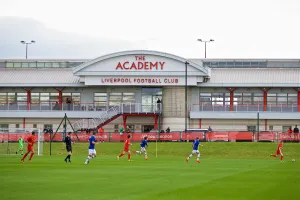Liverpool have announced a landmark £20 million redevelopment project at their Kirkby training ground, signalling the biggest investment in their youth system for nearly three decades. The move reflects the club’s determination to strengthen the pathway between academy prospects and the first team while modernising facilities to keep pace with domestic and European rivals.
Liverpool set for radical £20million redevelopment project with major upgradeshttps://t.co/snz1T4F8yI
— talkSPORT (@talkSPORT) September 4, 2025
The First Major Upgrade Since 1998
The Kirkby academy, which has produced a host of notable graduates including Trent Alexander-Arnold, Curtis Jones, and Steven Gerrard, has not seen a large-scale upgrade since 1998. While Liverpool’s move from Melwood to Kirkby in 2020 brought the senior and academy squads under one roof, critics and insiders alike have long argued that the youth facilities lagged behind elite standards set by clubs such as Manchester City and Chelsea.
1980-1998
— Tom 🏴 (@LFCTom36) January 10, 2025
Born in Whiston in May 1980, Gerrard first began his career playing for Whiston Juniors, the local team.
At the age of 9, he was picked up by Liverpool’s academy.
His career was nearly derailed in a bizarre garden incident, but he dodged the amputation if his toe. pic.twitter.com/G7FtGYpZgX
This new project is designed to change the landscape of Liverpool’s academy for years to come. Central to the plans is the construction of a full-size domed grass pitch, which will allow year-round training regardless of Merseyside’s often harsh weather. For players in the crucial stages of their development, uninterrupted training time could prove invaluable in maintaining both technical sharpness and physical conditioning.
Another major addition will be a 500-seat spectator stand, giving academy and youth fixtures a genuine matchday atmosphere. This not only benefits the players—who will gain experience performing in front of a crowd—but also creates a more welcoming environment for families, supporters, and scouts eager to see the next generation in action.
Beyond the pitch, the redevelopment will also bring significant improvements to the academy’s infrastructure. Upgraded medical, sports science, and rehabilitation facilities are set to give Liverpool’s youngsters access to the same level of care afforded to the senior squad. The idea is to ensure that prospects grow into athletes equipped for the demands of Premier League football.
Finally, the project includes enhanced classroom and learning spaces, reflecting Liverpool’s long-standing philosophy of “educate the player, educate the person.” By investing in both football and academic development, the club is reinforcing its commitment to shaping well-rounded individuals who can thrive on and off the pitch.
Why Now?
Liverpool’s academy has long been regarded as a proud part of the club’s identity. Yet as rivals invested hundreds of millions into state-of-the-art complexes, pressure grew for the Reds to act.
The decision aligns with a broader strategic vision for 2028, when the project is scheduled for completion. By then, Liverpool aim to have built a pipeline of homegrown talent capable of easing financial pressures in the transfer market while reinforcing the club’s cultural DNA.
In recent seasons, Premier League clubs have spent record-breaking sums in the transfer market. For Liverpool, who have historically balanced marquee signings with academy breakthroughs, investing in youth development offers a cost-effective alternative.
The Legacy of Klopp and the Academy
Although Jürgen Klopp has since departed Liverpool, his influence continues to loom large over the direction of the club’s academy. During his tenure, Klopp consistently championed the integration of young players into the senior setup, handing debuts to more than a dozen academy prospects between 2015 and 2024.
Another memorable night for the LFC Academy. 7 graduates all involved and on the pitch during this win 👏⚽️
— Neil Mellor (@NeilMellor33) September 27, 2023
Curtis captain, Quansah and Doak 1st Anfield starts, Kelleher finished captain, Elliott full 90, Bajcetic off bench and Chambers debut 🔴🙌#Academy #LFC pic.twitter.com/pGGZH9jv87
The success stories of Trent Alexander-Arnold and Curtis Jones serve as the most visible proof of that philosophy, both becoming established first-team regulars under Klopp’s guidance. Others, such as Harvey Elliott, Tyler Morton, and Stefan Bajčetić, also highlighted the value of nurturing talent within Liverpool’s system rather than relying solely on external recruitment.
🚨🏴 𝐎𝐅𝐅𝐈𝐂𝐈𝐀𝐋 | Aston Villa sign Harvey Elliot (22) from Liverpool! 🟣🔵
— EuroFoot (@eurofootcom) September 1, 2025
Loan with obligation to buy for around £35m package, as per @FabrizioRomano. 🪄 pic.twitter.com/XoGbisvmCC
In many ways, this £20 million overhaul represents both a legacy of Klopp’s era and a forward-looking investment by Liverpool’s current hierarchy. The German may no longer be at the helm, but the culture he instilled—where academy players are trusted, developed, and given a pathway to the first team—remains at the heart of the club’s long-term vision.
Comparisons Across the Premier League
Liverpool’s rivals have set an undeniably high bar in recent years when it comes to youth development infrastructure. Manchester City’s Etihad Campus is often regarded as the gold standard, with its combination of cutting-edge indoor pitches, luxury player accommodations, and seamless integration between the academy and first team. The complex reflects City’s vision of building not only elite footballers but also a unified club culture from the ground up.
LATEST Etihad Campus Flyover 🚁 pic.twitter.com/lF3WFY89yT
— Barney Blue Moon (@Barney_City) October 14, 2024
Chelsea, meanwhile, have established Cobham as a symbol of academy excellence. Over the past decade, it has become a breeding ground for top-level talent, producing England internationals such as Mason Mount, Reece James, and Levi Colwill. Cobham’s facilities, combined with Chelsea’s willingness to promote from within, have given the club a reputation as one of the most consistent producers of Premier League-ready players.
Behind the scenes at Cobham. 🎥 pic.twitter.com/b6Tir2rQIB
— Chelsea FC (@ChelseaFC) January 24, 2025
Arsenal’s Hale End academy has also enjoyed a resurgence, particularly in the Mikel Arteta era. The likes of Bukayo Saka and Emile Smith Rowe have emerged as central figures for both club and country, showcasing the importance of homegrown talent to Arsenal’s “core identity” approach. Hale End is celebrated not just for technical excellence, but also for fostering players who embody Arsenal’s values on and off the pitch.
Wanna have a look behind the scenes at Hale End after its re-development?
— Arsenal (@Arsenal) March 31, 2017
Check out this... pic.twitter.com/WzmVbnpgWc
By contrast, Liverpool’s Kirkby training ground has often been viewed as functional rather than groundbreaking. While it has produced some notable graduates, it lacked the polish and scale of its rivals’ facilities. That perception, however, is set to change. The club’s £20 million redevelopment project, though not as financially extravagant as Manchester City’s outlay, is designed to bring Kirkby into a new era. Once complete, it will position Liverpool firmly back in the conversation for best-in-class youth development, aligning their infrastructure with the ambition of producing the next generation of Anfield stars.
Impact on the Next Generation
For Liverpool’s youth prospects, the redevelopment represents more than just new pitches and buildings—it is an investment in their futures.
🏴💎 Liverpool academy player Josh Sonni-Lambie (17) scored this. 🤯 pic.twitter.com/nKj5kVxUjF
— EuroFoot (@eurofootcom) August 19, 2025
The addition of a domed pitch will allow training continuity through Merseyside’s harsh winters, reducing disruptions and ensuring consistent player development. The spectator stand offers families and fans a closer connection to academy matches, turning otherwise low-profile games into events. Meanwhile, the medical and educational upgrades highlight Liverpool’s commitment to producing well-rounded athletes.
In the long term, the hope is that the overhaul will create an environment where players not only develop technically and physically but also feel fully part of the Liverpool identity before stepping onto Anfield’s turf.
Rio Ngumoha, just 16, breaking lines for fun and scores a late winner v Newcastle that’s up for Goal of the Month. The way he split their midfield before rifling it in was textbook. 5/2 for the award – someone tell the Liverpool Academy to slow down!pic.twitter.com/F7kASCaKk3
— Danny Odds (@OddsDanny) September 4, 2025
The Road Ahead
Construction is scheduled to begin in early 2026, with phased openings expected before full completion in 2028. During this period, Liverpool’s academy operations will continue without interruption, though some fixtures may be relocated temporarily.
The investment underscores a central truth: Liverpool see their academy not just as a feeder for the first team, but as a cornerstone of the club’s future stability. In an era where transfer fees spiral ever higher, homegrown talent represents both cultural value and financial prudence.
Liverpool’s £20 million academy overhaul marks the dawn of a new chapter for Kirkby. More than just bricks and mortar, it is a statement of intent: that the club will not be left behind in the Premier League’s arms race for facilities and talent.
With a proud history of nurturing local heroes and a philosophy rooted in opportunity, Liverpool are betting that their future stars will emerge from this revamped academy—ready to carry the torch of Anfield tradition into the decades ahead.



